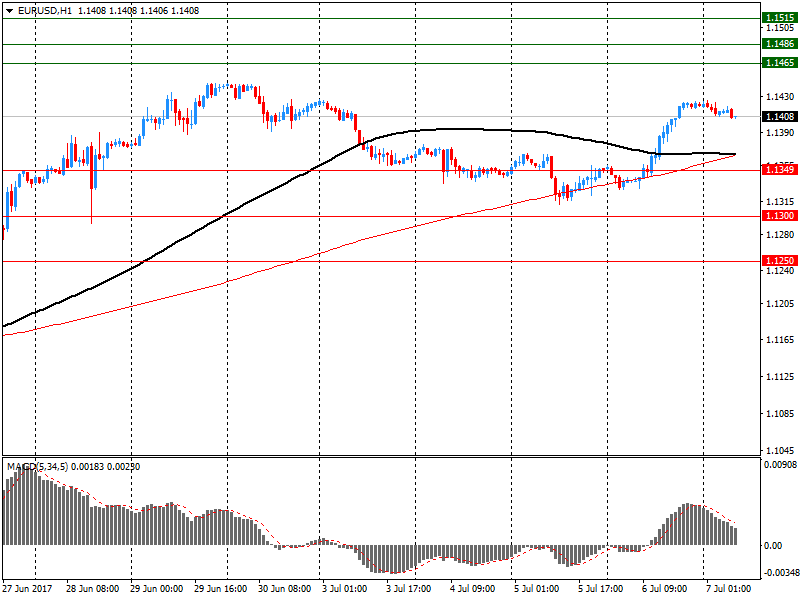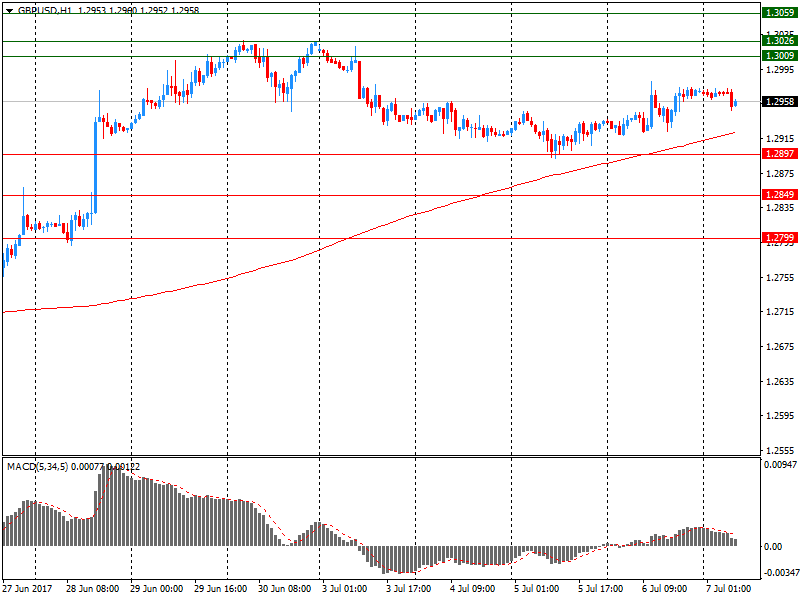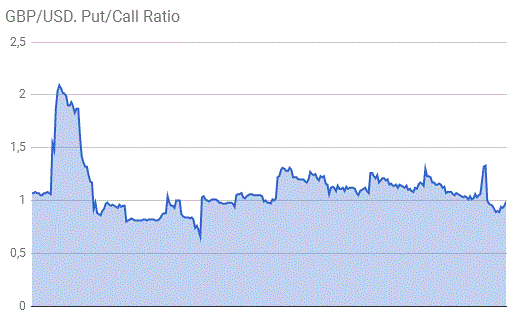Noticias del mercado
-
19:04
U.S.: Baker Hughes Oil Rig Count, July 763
-
16:29
Putin says to Trump I'm delighted to meet you personally and I hope our meeting will bring results
-
Trump does not answer shouted question from reporters about russian meddling in U.S. election
-
Trump says we look forward to a lot of positive things happening for Russia and US
-
-
16:00
Canada: Ivey Purchasing Managers Index, June 61.6
-
15:51
OPEC - led oil producer group not actively discussing further measures yet - Reuters citing 3 OPEC sources
-
15:46
ECB officials are said to see ABS program as largely redundant. Officials said to wonder if ABS program still warranted - Bloomberg
-
15:46
Option expiries for today's 10:00 ET NY cut
EURUSD: 1.1300 (EUR 365m) 1.1325 (450m) 1.1400 (1.14bln) 1.1430 (630m) 1.1450 (215m) 1.1500 (485m)
USDJPY: 112.00 (USD 865m) 112.15 (360m0 112.50 (350m) 113.00 (310m) 113.25 (350m) 113.45 (420m) 113.75 (390m) 113.90-114.00 (1.2bln) 114.75 (255m) 115.00 (380m)
GBPUSD: 1.2725 (GBP 460m)
AUDUSD: 0.7500 (AUD 240m) 0.7565 (300m) 0.7600 (375m) 0.7650 (810m) 0.7720-30 (550m) 0.7750 (350m)
-
15:45
Canadian employment rose by 45,000 in June, mostly in part-time work
Employment rose by 45,000 in June, mostly in part-time work. The unemployment rate was 6.5%, down 0.1 percentage points from the previous month.
Compared with 12 months earlier, there were 351,000 (+1.9%) more people employed. Most of the growth was in full-time work (+248,000 or +1.7%), while part-time employment was also up (+103,000 or +3.0%). The total number of hours worked increased 1.4% over this period.
In the second quarter of 2017, overall employment grew by 103,000 (+0.6%), the fourth consecutive quarter of strong employment growth and the largest quarterly increase since 2010. In the first half of 2017, employment grew by 186,000 (+1.0%), compared with 64,000 (+0.4%) over the first half of 2016.
-
15:40
NFP tops expectations in June
Total nonfarm payroll employment increased by 222,000 in June, and the unemployment rate was little changed at 4.4 percent, the U.S. Bureau of Labor Statistics reported today. Employment increased in health care, social assistance, financial activities, and mining.
In June, the unemployment rate, at 4.4 percent, and the number of unemployed persons, at 7.0 million, were little changed. Since January, the unemployment rate and the number of unemployed are down by 0.4 percentage point and 658,000, respectively.
The labor force participation rate, at 62.8 percent, changed little in June and has shown no clear trend over the past year. The employment-population ratio (60.1 percent) was also little changed in June and has held fairly steady thus far this year.
-
14:31
U.S.: Average workweek, June 34.5 (forecast 34.4)
-
14:31
U.S.: Labor Force Participation Rate, June 62.8%
-
14:31
U.S.: Private Nonfarm Payrolls, June 187 (forecast 172)
-
14:31
U.S.: Private Nonfarm Payrolls, June 187 (forecast 172)
-
14:31
U.S.: Nonfarm Payrolls, June 222 (forecast 179)
-
14:31
U.S.: Government Payrolls, June 35.0
-
14:31
U.S.: Manufacturing Payrolls, June 1.0 (forecast 5)
-
14:31
Canada: Employment , June 45.3 (forecast 10.0)
-
14:31
Canada: Unemployment rate, June 6.5% (forecast 6.6%)
-
14:30
U.S.: Average hourly earnings , June 0.2% (forecast 0.3%)
-
14:30
U.S.: Unemployment Rate, June 4.4% (forecast 4.3%)
-
14:11
United Kingdom: NIESR GDP Estimate, Quarter II 0.3%
-
13:15
US NFP the main event of the day, 170K expected vs 138K previous. Average hourly earnings expected to rise 0.3%
-
12:11
Putin says Russia views Paris climate change agreement as basis for long-term cooperation
-
11:26
Sterling hits nine-day low of 88.35 pence per euro after production and trade data, down 0.3 percent on day
-
10:42
UK construction output fell in May 2017 by 1.2%
Construction output fell in May 2017 by 1.2%, in both the month-on-month and 3 month on 3 month time series.
The 3 month on 3 month decrease represents the largest 3 month on 3 month fall in output since September 2012, driven by falls in both repair and maintenance, and all new work.
The main downward pressure on month-on-month growth came from all new work, most notably from infrastructure, which fell 4.0% following strong growth in April 2017.
Construction output also fell month-on-year, falling by 0.3% in May 2017, the first consecutive month-on-year decrease in output since May 2013.
Construction output for April 2017 has been revised up 0.5 percentage points from negative 1.6% to negative 1.1%.
-
10:40
The total UK trade (goods and services) deficit widened from £6.9 billion to £8.9 billion
Between the 3 months to February 2017 and the 3 months to May 2017, the total UK trade (goods and services) deficit widened from £6.9 billion to £8.9 billion.
The widening of the trade deficit in the 3 months to May 2017 reflects a higher rise in imports than the rise in exports of goods, in particular transport equipment (cars, aircraft and ships), oil and electrical machinery from non-EU countries; a decrease in exports of services also contributed.
Between the 3 months to February 2017 and the 3 months to May 2017, the total UK trade (goods and services) excluding erratics deficit widened from £8.6 billion to £9.3 billion.
The total UK trade (goods and services) deficit widened by £1.0 billion between April and May 2017 to £3.1 billion, following a narrowing in April 2017; this reflects an increase in imports of goods on the month following a decrease in April 2017.
Import prices increased by 0.5% in the 3 months to May 2017 whereas export prices remained flat; however, excluding the impact of falling oil prices, import and export prices grew by 1.0% and 0.5% respectively.
-
10:38
The UK Index of Production was estimated to have decreased by 1.2%, due mainly to falls of 1.1% in manufacturing and 3.5% in energy supply
In the 3 months to May 2017 compared with the 3 months to February 2017, the Index of Production was estimated to have decreased by 1.2%, due mainly to falls of 1.1% in manufacturing and 3.5% in energy supply.
The largest contribution to the fall in manufacturing came from the highly volatile pharmaceutical industry along with a range of other industries while the fall in energy supply was due largely to warmer temperatures.
In the 3 months to May 2017 compared with the same 3 months a year ago, the Index of Production increased by 0.1%; this was due mainly to a rise of 0.9% in manufacturing where there were broad-based upwards contributions from most manufacturing industries.
In May 2017, total production was estimated to have decreased by 0.1% compared with April 2017, due to falls of 0.2% in manufacturing and 0.8% in energy supply; transport equipment provided the largest contribution to the manufacturing decrease, followed by food products, beverages and tobacco.
-
10:31
United Kingdom: Manufacturing Production (YoY), May 0.4% (forecast 1.0%)
-
10:30
United Kingdom: Industrial Production (MoM), May -0.1% (forecast 0.4%)
-
10:30
United Kingdom: Total Trade Balance, May -3.07
-
10:30
United Kingdom: Manufacturing Production (MoM) , May -0.2% (forecast 0.5%)
-
10:30
United Kingdom: Industrial Production (YoY), May -0.2% (forecast 0.2%)
-
09:37
UK house prices have flattened over the past three months
House prices in the three months to June were 2.6% higher than in the same period of 2016.
Prices in the three months to June were 0.1% lower than in the preceding quarter.
Martin Ellis, Halifax housing economist, said: "House prices have flattened over the past three months. Overall, prices in the three months to June were marginally lower than in the preceding three months. The annual rate of growth has fallen, to 2.6%; the lowest rate since May 2013. "Although employment levels continue to rise, household finances face increasing pressure as consumer prices grow faster than wages. This, combined the new stamp duty on buy to let and second homes in 2016, appears to have weakened housing demand in recent months. "A continued low mortgage rate environment, combined with an ongoing acute shortage of properties for sale should help continue to underpin house prices over the coming months."
-
09:31
United Kingdom: Halifax house price index, June -1% (forecast 0.2%)
-
09:30
United Kingdom: Halifax house price index 3m Y/Y, June 2.6% (forecast 3.1%)
-
09:10
In May, output bounced back sharply in the french manufacturing industry
In May 2017, output bounced back sharply in the manufacturing industry (+2.0% after −1.3% in April), as well as in the whole industry (+1.9% after −0.6%).
Manufacturing output grew sharply over the last three months in the manufacturing industry (+1.9%) as well as in the overall industry (+1.4%).
Output increased markedly in "other manufacturing" (+1.8%), in the manufacture of machinery and equipment goods (+3.0%), in the manufacture of transport equipment (+2.7%) and in the manufacture of food products and beverages (+1.2%). Conversely, it decreased sharply in mining and quarrying, energy, water supply (−2.0%) and in the manufacture of coke and refined petroleum products (−2.3%).
-
09:07
Switzerland: Foreign Currency Reserves, June 693
-
08:47
France: Industrial Production, m/m, May 1.9% (forecast 0.5%)
-
08:46
France: Trade Balance, bln, May -4.9 (forecast -5.1)
-
08:10
Options levels on friday, July 7, 2017
EUR/USD
Resistance levels (open interest**, contracts)
$1.1515 (3807)
$1.1486 (2940)
$1.1465 (2865)
Price at time of writing this review: $1.1408
Support levels (open interest**, contracts):
$1.1349 (2342)
$1.1300 (2788)
$1.1250 (2188)
Comments:
- Overall open interest on the CALL options and PUT options with the expiration date July, 7 is 79400 contracts (according to data from July, 6) with the maximum number of contracts with strike price $1,1100 (4791);
GBP/USD
Resistance levels (open interest**, contracts)
$1.3059 (2199)
$1.3026 (2084)
$1.3009 (2240)
Price at time of writing this review: $1.2958
Support levels (open interest**, contracts):
$1.2897 (2695)
$1.2849 (1429)
$1.2799 (3691)
Comments:
- Overall open interest on the CALL options with the expiration date July, 7 is 35756 contracts, with the maximum number of contracts with strike price $1,2800 (2350);
- Overall open interest on the PUT options with the expiration date July, 7 is 36683 contracts, with the maximum number of contracts with strike price $1,2800 (3691);
- The ratio of PUT/CALL was 1.03 versus 1.01 from the previous trading day according to data from July, 6
* - The Chicago Mercantile Exchange bulletin (CME) is used for the calculation.
** - Open interest takes into account the total number of option contracts that are open at the moment.
-
08:07
Swiss unemployment rate stable at 3.2% in June
According to the State Secretariat of Economic Affairs (SECO) surveys, 133'603 unemployed persons were registered at the Regional Employment Centers (RAV) at the end of June 2017, 6'175 less than in the previous month.
The unemployment rate thus fell from 3.1% in May 2017 to 3.0% in the reporting month. Compared to the previous month, unemployment fell by 5'524 persons (-4.0%). Youth unemployment in June 2017 Youth unemployment (15 to 24 year olds) fell by 848 persons (-5.7%) to 14'108. Compared to the previous year, this corresponds to a decrease of 1'683 persons (-10.7%).
-
08:05
German industrial production up 1.2% in May
In May 2017, production in industry was up by 1.2% from the previous month on a price, seasonally and working day adjusted basis according to provisional data of the Federal Statistical Office (Destatis). In April 2017, the corrected figure shows an increase of 0.7% (primary +0.8%) from March 2017.
In May 2017, production in industry excluding energy and construction was up by 1.3%. Within industry, the production of capital goods increased by 2.6% and the production of consumer goods by 1.4%. The production of intermediate goods showed a decrease by 0.2%. Energy production was up by 2.9% in May 2017 and the production in construction decreased by 1.0%.
-
08:00
Germany: Industrial Production s.a. (MoM), May 1.2% (forecast 0.3%)
-
07:45
Switzerland: Unemployment Rate (non s.a.), June 3.0% (forecast 3%)
-
07:16
Japan: Coincident Index, May 115.5
-
07:16
Japan: Leading Economic Index , May 104.7 (forecast 104.6)
-
02:00
Japan: Labor Cash Earnings, YoY, May 0.7% (forecast 0.4%)
-
01:30
Australia: AiG Performance of Construction Index, June 56
-
00:27
Currencies. Daily history for Jul 06’2017:
(pare/closed(GMT +2)/change, %)
EUR/USD $1,1420 +0,61%
GBP/USD $1,2969 +0,26%
USD/CHF Chf0,9604 -0,34%
USD/JPY Y113,17 -0,02%
EUR/JPY Y129,24 +0,60%
GBP/JPY Y146,77 +0,25%
AUD/USD $0,7581 -0,28%
NZD/USD $0,7274 -0,16%
USD/CAD C$1,2976 +0,15%
-


